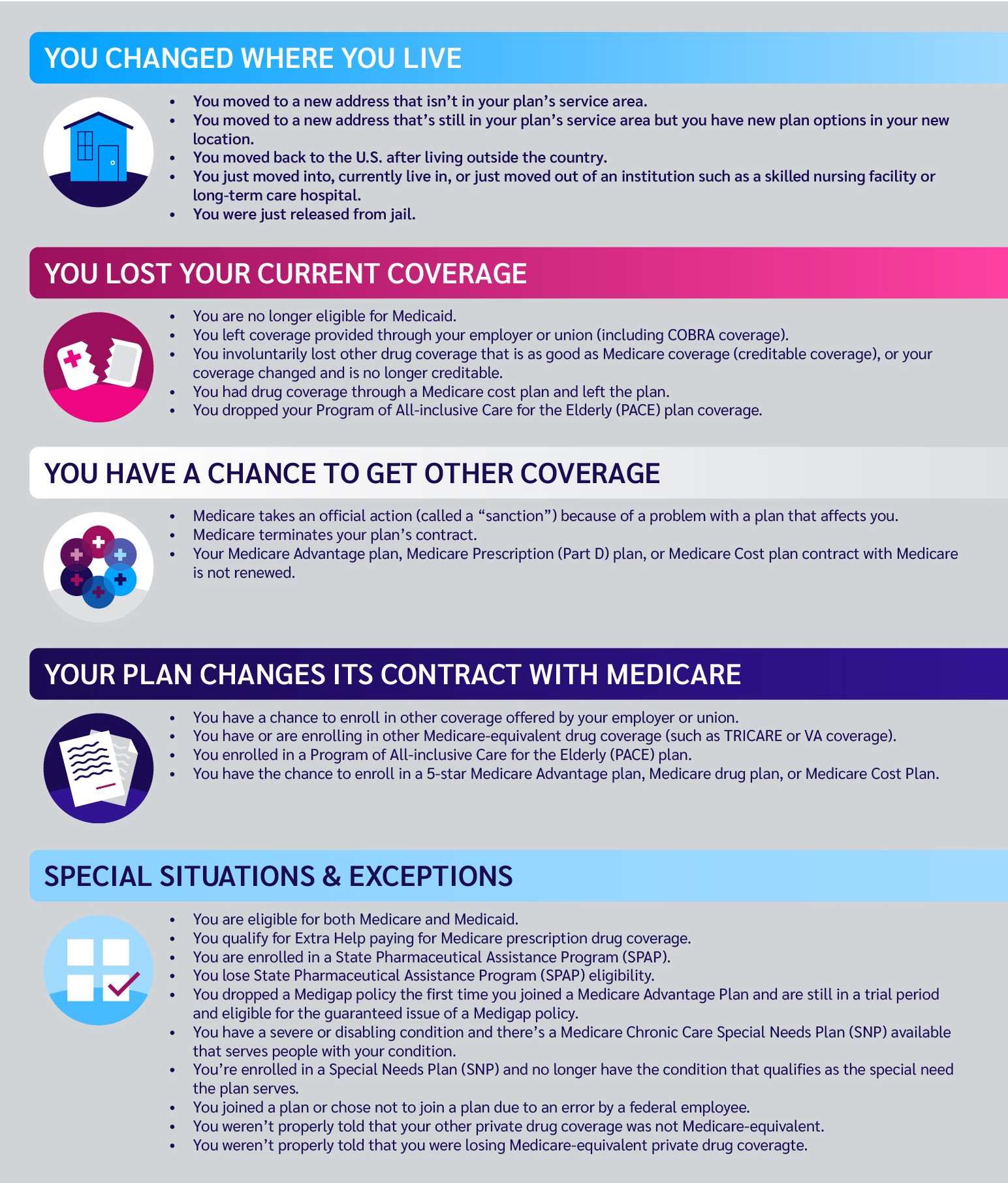A non-government site, powered by Clearlink Insurance
Review our helpful Medicare SEP Chart
Learn about the Medicare Special Enrollment Periods that allow you to enroll in a new plan outside of the Annual Enrollment Period.

Key Takeaways:
- A Medicare Special Enrollment Period (SEP) is triggered by a certain event and allows for enrolling, changing, or dropping Medicare coverage outside of standard enrollment periods.
- Common SEP triggers include moving to an area where your Medicare coverage is no longer valid or losing other medical coverage.
- The length of a Special Enrollment Period depends on the triggering event.
While the primary time to enroll in a Medicare plan is the Annual Enrollment Period (AEP) lasting from October 15 through December 7 each year, certain circumstances can trigger a Special Enrollment Period (SEP), which allows you to enroll or change your plan outside of AEP. Read on to learn more about the events that can trigger an SEP and view a comprehensive chart listing all of these events below.
What is a Medicare Special Enrollment Period (SEP)?
Simply put, a Medicare Special Enrollment Period (SEP) is an enrollment period outside of the usual Annual Enrollment Period when you can enroll in Medicare plans or change your coverage. Special Enrollment Periods are triggered by certain events. Common SEP triggers include moving to an area where your Medicare coverage is no longer valid or losing other medical coverage. A comprehensive list and short but detailed explanations follow.
What events trigger an SEP?
The events that trigger a Special Enrollment Period (SEP) fall under five major categories according to the official government resource at Medicare.gov:
- You change where you live
- You lose your current coverage
- New coverage becomes available to you
- Your plan changes its contract with Medicare
- Special situations and exceptions
Within these five categories are the specific triggering events.

You changed where you live
You moved to a new address that isn’t in your plan’s service area.
During this SEP, you can switch to a new Medicare Advantage Plan or Medicare drug plan. If you tell your plan before your move, your Special Enrollment Period encompasses the month you move plus the following two months. If you tell your plan after you move, your SEP begins the month you tell your plan plus the following two months.
You moved to a new address that’s still in your plan’s service area but you have new plan options in your new location.
During this SEP, you can switch to a new Medicare Advantage Plan or Medicare drug plan. If you tell your plan before your move, your Special Enrollment Period encompasses the month you move plus the following two months. If you tell your plan after you move, your SEP begins the month you tell your plan plus the following two months.
What is a Medicare beneficiary?
A Medicare beneficiary is someone who is entitled to Medicare benefits. Medicare is primarily for people 65 and older, but can also be available to younger people with illnesses like ESRD and ALS.
You moved back to the U.S. after living outside the country.
During this SEP, you can switch to a new Medicare Advantage Plan or Medicare drug plan. Your Special Enrollment Period lasts for two full months after the month you move back to the U.S.
You just moved into, currently live in, or just moved out of an institution such as a skilled nursing facility or long-term care hospital.
During this SEP, you can join a Medicare Advantage Plan or Medicare drug plan, switch from your current Medicare Advantage Plan or Medicare drug plan to another plan, drop your Medicare Advantage plan and return to Original Medicare, or drop your Medicare prescription drug coverage. Your Special Enrollment Period lasts as long as you live in the institution and for two full months after leaving.
You lost your current coverage
You are no longer eligible for Medicaid.
During this SEP, you can join a Medicare Advantage Plan or Medicare drug plan, switch from your current Medicare Advantage Plan or Medicare drug plan to another plan, drop your Medicare Advantage plan and return to Original Medicare, or drop your Medicare prescription drug coverage. Your Special Enrollment Period lasts for three full months from either the date you are no longer eligible for Medicaid or the date you are notified, whichever is later.
You left coverage provided through your employer or union (including COBRA coverage).
During this SEP, you can join a Medicare Advantage Plan or Medicare drug plan. Your Special Enrollment Period lasts a full two months after the month your coverage ends.
You involuntarily lost other drug coverage that is as good as Medicare coverage (creditable coverage), or your coverage changed and is no longer creditable.
During this SEP, you can enroll in a Medicare Advantage plan with drug coverage or a Medicare prescription drug plan. Your Special Enrollment Period lasts for three full months from either the date you lose your coverage or the date you are notified, whichever is later.
You had drug coverage through a Medicare Cost Plan and left the plan.
During this SEP, you can join a Medicare drug plan. Your SEP lasts for two full months after you drop your Medicare Cost Plan.
You dropped your Program of All-inclusive Care for the Elderly (PACE) plan coverage.
During this SEP, you can join a Medicare Advantage Plan or Medicare drug plan. Your Special Enrollment Period lasts a full two months after the month you drop your PACE plan.
You have a chance to get other coverage
You have a chance to enroll in other coverage offered by your employer or union.
During this SEP, you can join, switch, or drop your Medicare Advantage Plan or Medicare drug coverage. These Special Enrollment Periods allow for one change each between January and March, April and June, and July and September. Any changes made take effect on the first day of the following month.
You have or are enrolling in other Medicare-equivalent drug coverage (such as TRICARE or VA coverage).
During this SEP, you can drop your current Medicare Advantage Plan with drug coverage or your Medicare drug plan. This SEP can be triggered anytime.
You enrolled in a Program of All-inclusive Care for the Elderly (PACE) plan.
During this SEP, you can drop your current Medicare Advantage Plan or your Medicare drug plan. This SEP can be triggered anytime.
You have the chance to enroll in a 5-star Medicare Advantage plan, Medicare drug plan, or Medicare Cost Plan.
Medicare uses customer satisfaction surveys and information from healthcare providers to rate plans from 1-5 stars, with 5 being the best. Ratings change each year, meaning the availability of 5-star rated plans in your area may change, with plans newly rated 5 stars appearing yearly. You can use this Special Enrollment Period to enroll in a plan with a 5-star quality rating once between December 8 and November 30 of the following year.
Your plan changes its contract with Medicare
Medicare takes an official action (called a “sanction”) because of a problem with a plan that affects you.
During this SEP, you can switch from your Medicare Advantage Plan or Medicare drug plan to another plan. Medicare determines the SEP’s length on a case-by-case basis.
Medicare terminates your plan’s contract.
During this SEP, you can switch from your Medicare Advantage Plan or Medicare drug plan to another plan. The SEP begins two months before the contract ends and ends one full month after the contract ends.
Your Medicare Advantage plan, Medicare Prescription (Part D) plan, or Medicare Cost plan contract with Medicare is not renewed.
During this SEP, you can join either a Medicare drug plan or a Medicare Advantage Plan with drug coverage. This change can be made once per calendar year.
Special situations and exceptions
You are eligible for both Medicare and Medicaid.
During this SEP, you can join, switch, or drop your Medicare Advantage Plan or Medicare drug coverage. These Special Enrollment Periods allow for one change each between January and March, April and June, and July and September. Any changes made take effect on the first day of the following month.
You qualify for Extra Help paying for Medicare prescription drug coverage.
During this SEP, you can join, switch, or drop your Medicare drug coverage. These Special Enrollment Periods allow for one change each between January and March, April and June, and July and September. Any changes made take effect on the first day of the following month.
You are enrolled in a State Pharmaceutical Assistance Program (SPAP).
During this SEP, you can join either a Medicare drug plan or a Medicare Advantage Plan with drug coverage. This change can be made once per calendar year.
You lose State Pharmaceutical Assistance Program (SPAP) eligibility.
During this SEP, you can join either a Medicare drug plan or a Medicare Advantage Plan with drug coverage. Your Special Enrollment Period begins either the month you lose your eligibility or the month you’re notified, whichever is later, and ends two full months later.
You dropped a Medigap policy the first time you joined a Medicare Advantage Plan and are still in a trial period and eligible for the guaranteed issue of a Medigap policy.
During this SEP, you can drop your Medicare Advantage Plan and enroll in Original Medicare with the special rights to buy a Medigap policy. This Special Enrollment Period lasts for 12 months after you enroll in the Medicare Advantage plan for the first time.
You have a severe or disabling condition and there’s a Medicare Chronic Care Special Needs Plan (SNP) available that serves people with your condition.
During this SEP, you can join a Medicare Chronic Care Special Needs Plan (SNP). You can join anytime but once you join your chance to make changes during this Special Enrollment Period ends.
You’re enrolled in a Special Needs Plan (SNP) and no longer have the condition that qualifies as the special need the plan serves.
During this SEP, you can switch from a Special Needs Plan (SNP) to a Medicare Advantage Plan or Medicare drug plan. This Special Enrollment Period starts when you lose your special needs status and lasts up to three months after the end of your SNP’s grace period.
You joined a plan or chose not to join a plan due to an error by a federal employee.
During this SEP, you can join a Medicare Advantage Plan or Medicare drug plan, switch from your current Medicare Advantage Plan or Medicare drug plan to another plan, drop your Medicare Advantage plan and return to Original Medicare, or drop your Medicare prescription drug coverage. Your Special Enrollment Period lasts two full months after Medicare notifies you of the error.
You weren’t properly told that your other private drug coverage was not Medicare-equivalent.
During this SEP, you can join a Medicare Advantage plan with drug coverage or a Medicare prescription drug plan. Your Special Enrollment Period lasts two full months after Medicare notifies you of the error.
You weren’t properly told that you were losing Medicare-equivalent private drug coverage.
During this SEP, you can join a Medicare Advantage plan with drug coverage or a Medicare prescription drug plan. Your Special Enrollment Period lasts two full months after Medicare or your private carrier notifies you of the error.
Special Enrollment Period Triggering Events

A common SEP: Continuing work after 65 before retiring
Many people decide to continue work after age 65 to receive full Social Security Benefits. While you can keep your employer-provided health coverage during this time, it’s essential to enroll in Medicare Part A and a Medicare-equivalent drug plan during the Initial Enrollment Period (three months before the month of your 65th birthday, the month of your 65th birthday, and three months after). Enrolling in Part A during your Initial Enrollment Period prevents you from incurring penalties when you fully enroll in Medicare during the Special Enrollment Period triggered by your retirement.
The SEP triggered by retirement begins as soon as you stop working, even if you choose COBRA or other non-Medicare coverage, and lasts for eight months. Your coverage begins the month after Social Security gets your completed forms. During this SEP, you will either complete your enrollment in Original Medicare (Part B in addition to the Part A you already enrolled in) in combination with a Medigap and/or Medicare Part D plan or enroll in a private Medicare Advantage plan.

What can I do during an SEP?
Depending on what triggers your Special Enrollment Period (SEP), you can add or drop different aspects of your Medicare coverage. Here are examples of what you can do during Special Enrollment Periods:
- Join a Medicare Advantage plan
- Join a Medicare prescription drug plan
- Switch from your current plan to another plan
- Drop a Medicare Advantage plan and return to Original Medicare
- Drop Medicare prescription drug coverage
For more detail on what you can do during your SEP, find the specific triggering event and related info above.
How long do I have to enroll during an SEP?
The length of time you have to make changes during a Special Enrollment Period depends on the event that triggers your SEP. Special Enrollment Periods can be as long as twelve months and as short as two, with many SEPs’ lengths determined at Medicare’s discretion.
See details of the timing associated with your particular triggering event above.
How do I change my Medicare plan during an SEP?
During a Special Enrollment Period, instructions on what to do vary depending on whether you’re adding or dropping coverage, joining a Medicare Advantage plan or Original Medicare, or enrolling in a Special Needs Plan. For example, if you intend to drop your Medicare Advantage Plan and return to Original Medicare, you’ll need to follow the directions at www.ssa.gov/benefits/medicare.
If you plan on moving from Original Medicare to a Medicare Advantage plan through a private provider, on the other hand, we recommend working with an insurance agency like ours. Here are just a few of the benefits of working with our agency:
- Our agents are U.S.-based and U.S.-licensed
- We represent several different insurance providers and can offer unbiased help finding the plan that fits your needs and your budget
- You can browse plans on your own to compare differences and get transparency in plan offerings
- You can enroll online or over the phone
If you qualify for a Special Enrollment Period and would like help finding a new plan, you probably have questions. Sometimes it’s easiest to talk to an expert—get in touch with our team by phone at 1-855-200-9406 or browse available plans online.
Helpful resources:
https://www.medicare.gov/basics/get-started-with-medicare/get-more-coverage/joining-a-plan/special-enrollment-periodshttps://www.medicare.gov/basics/get-started-with-medicare/medicare-basics/working-past-65/getting-medicare-when-you-retirehttps://www.ssa.gov/medicarehttps://www.ssa.gov/pubs/EN-05-10012.pdf
Who We Are
Healthcareplans.com partners with leading insurance brands to help consumers compare and select plans during Medicare’s Annual Enrollment Period, Open Enrollment Period, and Special Enrollment Periods.
Working with Clearlink Insurance Agency, Healthcareplans.com connects you with the information needed to make an informed Medicare decision.
To compare plans, get started below.